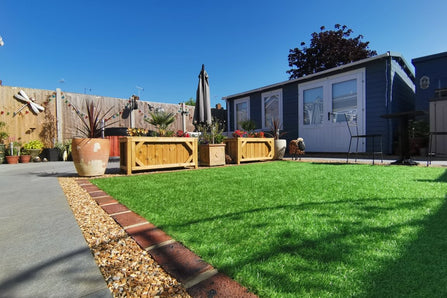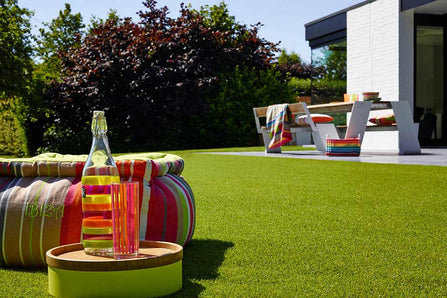How to look after artificial grass in winter
Posted on by Grass 247
How to look after artificial grass in winter
In the peak of UK winter, it can be easy to overlook our lawn and garden care. It can be tempting to just leave your grass alone for the entirety of winter and autumn when we’re naturally using our gardens less, but our gardening experts here at Grass247 stress the importance of keeping on top of your artificial grass care in the colder months.
While artificial grass isn’t a living thing, it still requires a low level of maintenance to keep it looking great in your garden, despite common misconceptions that it requires no maintenance.
Just like real grass, artificial turf requires proper care (albeit significantly less) to maintain its appearance and functionality all year round. Not only will doing so make a big difference to your garden over winter, but you’ll also reap the benefits of it in early spring when your artificial lawn looks as luscious as it did in the summer.
With this in mind, we’ve compiled a list of the seven essential artificial grass care tips you should do to help keep it in top condition during the colder season. Check them out below.
7 essential artificial grass care tips for winter

1. Remove debris regularly
Keep your lawn free from debris, such as fallen twigs or leaves blown in by winter storms. Anyone who has trees in or surrounding their garden will know the pain of clearing up fallen leaves in the winter.
Leaves, twigs, and other debris from shedding trees can easily build up on top of our lawns in the winter months, which traps moisture and can cause all sorts of problems like fungal and mould growth.
To avoid these, it’s important to regularly clean debris from the top of your artificial grass using a brush or leaf blower. Avoid heavy metal rakes as these could damage artificial grass fibres.
2. Brush the grass
Another key thing to do when it comes to caring for artificial grass in winter is to brush the grass to keep the fibres upright using an artificial grass rake.
After the summer season, when we naturally spend more time in our gardens, the fibres of artificial grass can become flattened, and if they stay that way throughout the winter, they may not bounce back as easily next summer.
Simply use a stiff broom to plush the fibres and keep the grass looking full. Regular brushing is especially important during winter, as frost or light snow can also weigh down the fibres.
3. Avoid salt or deicers
In the winter, it can be tempting to use salt and deicers to try and protect your artificial grass, but even the most natural of deicers can cause significant problems for your lawn.
Using deicers like salt or grit to melt the snow can damage your artificial grass underlay and clog the drainage system. Not to mention potentially cause damage to pets’ paws.
Instead, opt for the use of sand to provide grip without causing damage to the turf.
Worried about how artificial grass will affect your pets? Check out our top tips for keeping artificial grass cool in summer to protect their paws.
4. Check drainage
January’s persistent rainfall can highlight drainage issues in your artificial turf. Ensure all drainage channels are clear to avoid standing water that could freeze.
To do this, look out for signs of standing water, clogged drains, or compacted sub-base materials.
5. Heavy snowfall? Shovel carefully
If you find yourself wondering “how does artificial grass hold up in snow?”, you shouldn’t worry too much about a thin layer of snow covering your artificial grass.
However, you should avoid letting it build up during heavy snowfall, as it can become compacted and turn into ice, which can potentially damage the artificial grass fibres and put excessive stress on the drainage system.
There isn’t really any chemical that is better for your grass than a good shovel and a little sweat, so, instead of relying on chemical deicers to melt the snow, it’s best to just use a plastic shovel (not metal) to avoid tearing the surface.
Areas like the Scottish Highlands, where snow is common in January, will benefit from this careful approach.
6. Allow the ice to melt naturally
If your artificial grass develops icy patches, avoid trying to scrape the ice away and simply allow the ice to melt naturally.
For faster results, pour warm (not boiling) water over the area, a safe method during frosty UK mornings.
7. Inspect for damage
Thankfully winter has its benefits as it creates a quieter gardening period, giving you plenty of time to thoroughly inspect your artificial grass.
It’s important to check for tears, loose seams, or other damage caused by December’s storms or frosts, and address any issues promptly before peak garden season begins.
If you’re struggling to find suitable artificial grass care products, check out our comprehensive, high-quality accessories.
From adhesives to underlays to pegs and pins, Grass247 have everything you need to have a stunning-looking that lasts.



